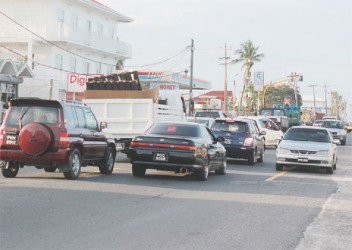Plans for a four-lane highway for Sheriff Street have been shelved after objections were raised by businesses but sidewalks and other improvements remain part of a US$24M project
that will also greatly transform Mandela Avenue.
The Ministry of Public Works project would create a less congested link between the East Coast and East Bank Highways via the Sheriff Street/Mandela Avenue corridor.
This initiative has been undertaken as part of the government’s Sustainable Urban Transport Plan aimed at providing a “holistic approach to improving traffic circulation within the city,” and focusing on the way public transport operators provide this service.
The Ministry’s Manager of Technical Services Rabindranauth Chanderpal says that the idea was born after they recognised that the Sheriff Street/Mandela Avenue corridor is plagued by a lot of problems, including congestion.

The ministry is of the view that the prevailing conditions along the corridor have resulted fatalities and other less serious accidents. These factors, according to Chanderpal, prompted the ministry to seek out ways to improve conditions along the corridor.
The ministry, Chanderpal explained, came up with the concept of improving drainage as well as installing sidewalks, and parking and stopping facilities from the head of Sheriff Street, at the Rupert Craig Highway, to Francoise Street, Section K Campbellville.
Additionally, the entire length of Mandela Avenue, from Francoise Street the beginning of the East Bank Highway, will be widened by an additional two lanes.
The hope is, Chanderpal posited, that traffic coming from along the East Bank Highway will be able to comfortably travel on two lanes along Mandela Avenue before using one of the western corridors in the city – Princes Street, D’urban Street, Norton Street and Croal Street – to get to their destinations.
This, he said, would alleviate much of the congestion which is common along Lombard and Hunter streets, especially during peak hours.
The preliminary design for these works has already been completed and is currently being reviewed by the ministry. The project cost of US$24 million is being sourced from the Inter-American Development Bank (IDB), which has already indicated its interest in making the amounts available. As is obvious, this project will be carried out in a major business as well as a residential epicentre and will have an impact on them.
Entities which, in the past, failed to engage those to be affected by such projects have come under fire but Chanderpal says this will not be the case with this project.
In fact, he said that the design currently under review is a product of a lot of preparation work, including extensive consultations with stakeholders.
The consultations, he shared, were done by a social engagement expert hired by the ministry, and another independent expert hired by the IDB. Together, these consultants facilitated a series of consultations with various stakeholders such as large and small business owners, schools, as well as individuals who reside along the corridor.
In addition to these engagements, the first preliminary designs created were presented in June at an open forum at the North Ruimveldt Multilateral School for two days. The drawings for the designs, according to Chanderpal, were posted on the walls of the school where members of the public could look at them and give their critique.
Asked about the attendance at the consultations, Chanderpal gave assurances that the sessions were well advertised, primarily via the radio, and added that attendance was also very good. The consultants, also reportedly moved from store to store along Sheriff Street to ensure that each business owner was at least aware of the coming consultations.

“Based on the feedback the consultants have refined the preliminary design and this is now being reviewed by the ministry and the IDB,” Chanderpal explained.
One of the major changes made, he said, was the decision to abandon intentions of making both Sheriff Street and Mandela Avenue, four-lane roads. This change was informed by the business community along Sheriff Street who were “vehemently opposed” to having four lanes passing through that section.
These developments then led to the decision to leave Sheriff Streets with just two lanes. However sidewalks, and designated stopping facilities will still be installed. The sidewalks, he said, will benefit the residents of the area who are concerned for their safety as they move along Sheriff Street, while the stopping areas will serve to ensure traffic is not stalled when a bus, car, or any other vehicle has to stop.
Despite the fact that the preliminary designs are currently being reviewed, the consultations have not concluded. In fact, they will continue throughout the design process and well as during the execution of the works, according to Chanderpal.
In addition, a multi-stakeholder committee, elected by those who attended the various consultations, will remain in place to articulate the interests of those they represent to the ministry so that they can be addressed.





